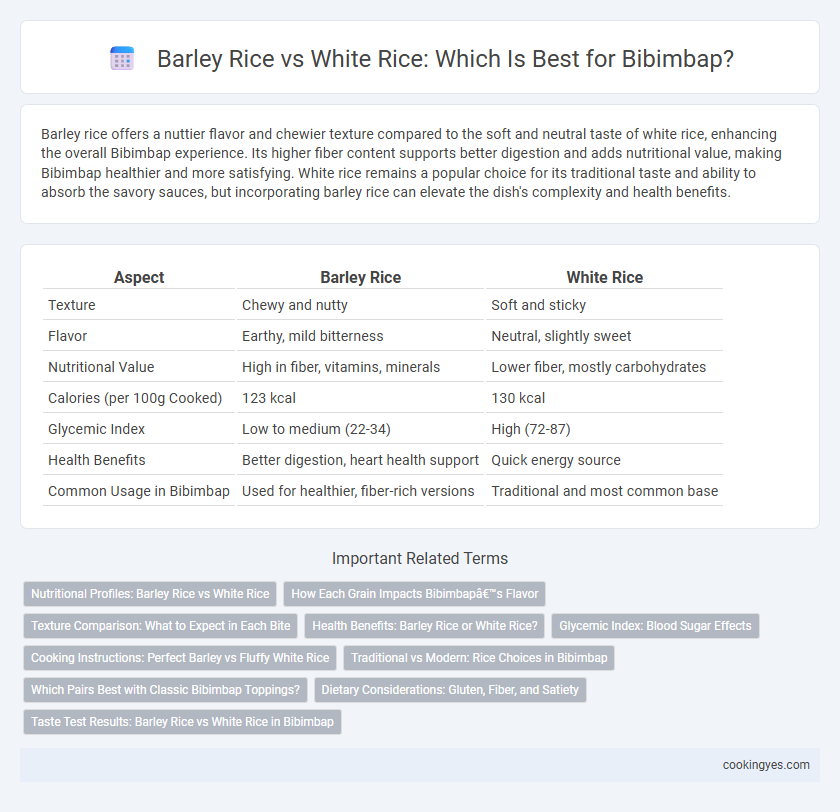Barley rice offers a nuttier flavor and chewier texture compared to the soft and neutral taste of white rice, enhancing the overall Bibimbap experience. Its higher fiber content supports better digestion and adds nutritional value, making Bibimbap healthier and more satisfying. White rice remains a popular choice for its traditional taste and ability to absorb the savory sauces, but incorporating barley rice can elevate the dish's complexity and health benefits.
Table of Comparison
| Aspect | Barley Rice | White Rice |
|---|---|---|
| Texture | Chewy and nutty | Soft and sticky |
| Flavor | Earthy, mild bitterness | Neutral, slightly sweet |
| Nutritional Value | High in fiber, vitamins, minerals | Lower fiber, mostly carbohydrates |
| Calories (per 100g Cooked) | 123 kcal | 130 kcal |
| Glycemic Index | Low to medium (22-34) | High (72-87) |
| Health Benefits | Better digestion, heart health support | Quick energy source |
| Common Usage in Bibimbap | Used for healthier, fiber-rich versions | Traditional and most common base |
Nutritional Profiles: Barley Rice vs White Rice
Barley rice offers higher dietary fiber content and essential nutrients like beta-glucan, vitamins, and minerals compared to white rice, making it a more nutritious choice for bibimbap. While white rice provides a softer texture and quicker digestibility, it lacks the antioxidant compounds and lower glycemic index found in barley rice. Incorporating barley rice in bibimbap enhances its health benefits by promoting better digestion and sustained energy release.
How Each Grain Impacts Bibimbap’s Flavor
Barley rice offers a nutty, slightly chewy texture that enhances Bibimbap's earthy and robust flavors, providing a wholesome balance to the spicy gochujang and savory vegetables. White rice delivers a softer, more neutral base, allowing the vibrant seasonings and various toppings to stand out without competing for attention. Choosing barley rice deepens the dish's complexity, while white rice maintains traditional subtlety and harmony.
Texture Comparison: What to Expect in Each Bite
Barley rice offers a chewy, nutty texture that adds a satisfying bite to bibimbap, enhancing the dish's overall mouthfeel and complexity. White rice, in contrast, provides a soft, sticky base that allows the flavors of the toppings and sauce to meld smoothly. Choosing barley rice results in a heartier, more textured experience, while white rice delivers a classic, tender foundation for traditional bibimbap.
Health Benefits: Barley Rice or White Rice?
Barley rice offers higher dietary fiber content compared to white rice, promoting better digestion and sustained energy levels in bibimbap. It contains essential minerals such as magnesium and selenium, which support heart health and antioxidant functions. White rice, while more digestible, lacks the nutritional density and fiber that barley rice provides, making barley rice the healthier choice for bibimbap enthusiasts seeking improved metabolic benefits.
Glycemic Index: Blood Sugar Effects
Barley rice has a lower glycemic index (GI) compared to white rice, leading to a slower, more gradual rise in blood sugar levels when used in bibimbap. The lower GI of barley rice helps improve insulin sensitivity and reduces the risk of blood sugar spikes, making it a healthier option for managing diabetes. White rice, with its higher GI, causes rapid increases in blood glucose, which can contribute to insulin resistance and metabolic imbalance over time.
Cooking Instructions: Perfect Barley vs Fluffy White Rice
For perfect barley rice in bibimbap, rinse the barley grains thoroughly and soak them for at least 30 minutes before cooking to ensure tenderness and even cooking. Use a 1:2 ratio of barley to water, and simmer on low heat for about 40-45 minutes until the grains are chewy but soft. For fluffy white rice, rinse until water runs clear to remove excess starch, use a 1:1.25 rice-to-water ratio, and cook with a tight lid on medium heat for 15 minutes before resting off heat for 10 minutes to achieve light, separate grains ideal for bibimbap texture contrast.
Traditional vs Modern: Rice Choices in Bibimbap
Traditional bibimbap commonly uses white rice for its soft texture and neutral flavor, enhancing the harmony of mixed vegetables, meat, and gochujang. Modern variations increasingly incorporate barley rice, valued for its chewy texture and higher fiber content, appealing to health-conscious consumers while maintaining the dish's balance. The choice between barley and white rice reflects evolving culinary preferences that blend heritage with nutritional awareness in bibimbap preparation.
Which Pairs Best with Classic Bibimbap Toppings?
Barley rice offers a nutty flavor and chewy texture that complements the savory and spicy toppings in classic bibimbap, enhancing the overall depth of the dish. White rice provides a neutral, slightly sticky base that allows the vibrant flavors of gochujang, sauteed vegetables, and marinated beef to shine without distraction. For those seeking a traditional bibimbap experience, white rice is ideal, while barley rice appeals to health-conscious eaters wanting added fiber and a robust mouthfeel.
Dietary Considerations: Gluten, Fiber, and Satiety
Barley rice offers higher dietary fiber compared to white rice, enhancing satiety and promoting digestive health in bibimbap dishes. While barley contains gluten, it may not be suitable for those with gluten intolerance or celiac disease, whereas white rice is naturally gluten-free and safer for sensitive individuals. Choosing between barley and white rice in bibimbap depends on balancing the benefits of increased fiber and fullness against potential gluten-related dietary restrictions.
Taste Test Results: Barley Rice vs White Rice in Bibimbap
Barley rice adds a nutty flavor and chewy texture to bibimbap, enhancing the dish's depth compared to the soft and neutral taste of white rice. Taste tests reveal that barley rice offers a more complex, hearty bite that complements the mixed vegetables and spicy gochujang sauce. White rice remains preferred for its traditional, mildly sweet profile that balances bold flavors without overpowering the overall dish.
Barley Rice vs White Rice for Bibimbap Infographic

 cookingyes.com
cookingyes.com